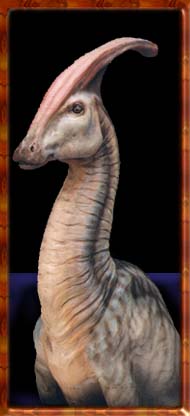Dinosaur Profile
Parasaurolophus walkeri
"Parasaur"
(Greek para
= "by" + Greek sauros = "lizard" +
Greek lophos = "crest")
Size:
9 meters (30 feet)
Period:
Late Cretaceous (76 million to 65 million years ago)
Place:
Alberta, Utah, New Mexico
 Able to walk on two feet
as easily as four, the duckbilled (lambeosaurine) Parasaur
is distinguished by its skull crest, an elongated, curved structure
longer than the entire skull. This crest contains two hollow tubes,
originally believed to be a respiratory device used in similar
fashion to a snorkel. However, the true purpose of the tubes turns
out to be for the creation of sound. The Parasaur is able to use
these tubes to communicate with its fellow herd members
through the emission of low-frequency vocal resonances.
Able to walk on two feet
as easily as four, the duckbilled (lambeosaurine) Parasaur
is distinguished by its skull crest, an elongated, curved structure
longer than the entire skull. This crest contains two hollow tubes,
originally believed to be a respiratory device used in similar
fashion to a snorkel. However, the true purpose of the tubes turns
out to be for the creation of sound. The Parasaur is able to use
these tubes to communicate with its fellow herd members
through the emission of low-frequency vocal resonances.
Environment:
The Parasaur generally abides - per original estimates - in the
forest region. It has, however, shown a remarkable adaptability
and has migrated at times to the plains, semi-arid, and most recently,
the swamp regions of the Park.
Feeding: Plant-eater.
Content to feast on the ferns and foliage of the forest, although
has demonstrated a new predilection for some of the water-based
mosses in the swamp area.
 Habits: The
Parasaurs tend to group in herds, falling into a rigid social
hierarchy. Males seem to achieve dominance in relation to the
coloration of their skull crests with the more spectacularly-plumed
Parasaurs adopting the leadership roles. Female social strata
appears to be based on resonance of voice - the females capable
of creating sounds at lower frequencies have repeatedly attracted
the attention of the more brightly-colored males.
Habits: The
Parasaurs tend to group in herds, falling into a rigid social
hierarchy. Males seem to achieve dominance in relation to the
coloration of their skull crests with the more spectacularly-plumed
Parasaurs adopting the leadership roles. Female social strata
appears to be based on resonance of voice - the females capable
of creating sounds at lower frequencies have repeatedly attracted
the attention of the more brightly-colored males.
Ops Notes:
Some concern over the Parasaurs' amazing adaptability. The skull
crest is retractable, allowing for rapid movement through dense
foliage. Several red flags have been raised over their highly-evolved
ability to communicate with one another: while it's a bit premature
to fear a Parasaur conspiracy, the beasts have demonstrated some
rudimentary higher-level linguistic skills rivaling those of some
monkeys.
Brachiosaur | Compy
| Dilophosaur | Gallimimus
| Parasaur
Psittacosaurus | Triceratops
| Tyrannosaurus | Velociraptor
| Exit
Copyright � 1996, Universal City Studios, Inc.
Web site designed by Z.M.Interactive.
 Able to walk on two feet
as easily as four, the duckbilled (lambeosaurine) Parasaur
is distinguished by its skull crest, an elongated, curved structure
longer than the entire skull. This crest contains two hollow tubes,
originally believed to be a respiratory device used in similar
fashion to a snorkel. However, the true purpose of the tubes turns
out to be for the creation of sound. The Parasaur is able to use
these tubes to communicate with its fellow herd members
through the emission of low-frequency vocal resonances.
Able to walk on two feet
as easily as four, the duckbilled (lambeosaurine) Parasaur
is distinguished by its skull crest, an elongated, curved structure
longer than the entire skull. This crest contains two hollow tubes,
originally believed to be a respiratory device used in similar
fashion to a snorkel. However, the true purpose of the tubes turns
out to be for the creation of sound. The Parasaur is able to use
these tubes to communicate with its fellow herd members
through the emission of low-frequency vocal resonances.
 Habits: The
Parasaurs tend to group in herds, falling into a rigid social
hierarchy. Males seem to achieve dominance in relation to the
coloration of their skull crests with the more spectacularly-plumed
Parasaurs adopting the leadership roles. Female social strata
appears to be based on resonance of voice - the females capable
of creating sounds at lower frequencies have repeatedly attracted
the attention of the more brightly-colored males.
Habits: The
Parasaurs tend to group in herds, falling into a rigid social
hierarchy. Males seem to achieve dominance in relation to the
coloration of their skull crests with the more spectacularly-plumed
Parasaurs adopting the leadership roles. Female social strata
appears to be based on resonance of voice - the females capable
of creating sounds at lower frequencies have repeatedly attracted
the attention of the more brightly-colored males.